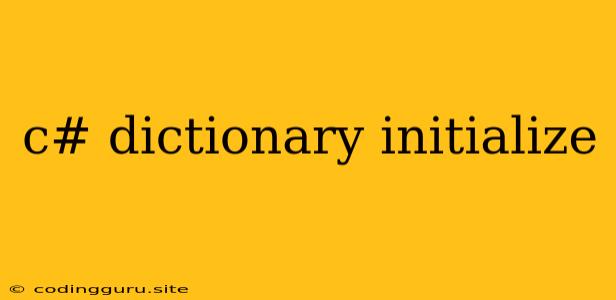Understanding C# Dictionaries: Initialization and Beyond
In the realm of C# programming, dictionaries serve as indispensable tools for storing and retrieving data efficiently. A dictionary, in essence, acts as a collection of key-value pairs, where each key uniquely identifies a corresponding value. This structure allows for swift access to specific data elements based on their associated keys. But the journey begins with understanding how to initialize a dictionary.
Why Use a Dictionary?
Let's delve into the reasons why dictionaries are so valuable in C# development:
-
Efficient Data Access: Dictionaries provide lightning-fast access to data based on their keys. Unlike arrays, where you need to iterate through elements, dictionaries allow you to directly retrieve values by specifying their keys.
-
Key-Value Pairs: The core concept of a dictionary is to associate keys with values. This organization makes it simple to store and retrieve related pieces of information.
-
Flexibility: Dictionaries can accommodate diverse data types for both keys and values, making them highly adaptable to different programming scenarios.
Initializing a C# Dictionary: A Guided Tour
Now, let's explore the various ways to initialize a C# dictionary:
1. Using the Dictionary<TKey, TValue> Constructor:
The most straightforward approach involves using the Dictionary<TKey, TValue> constructor:
Dictionary ages = new Dictionary();
This code creates a dictionary named ages where the keys are string types (e.g., "John", "Mary") and the values are int types (e.g., 30, 25).
2. Initializing with Values:
You can directly initialize the dictionary with key-value pairs during creation:
Dictionary capitals = new Dictionary()
{
{ "France", "Paris" },
{ "Germany", "Berlin" },
{ "Italy", "Rome" }
};
This example initializes a dictionary named capitals with key-value pairs for countries and their capitals.
3. Using the Add() Method:
If you prefer to add items to the dictionary after initialization, use the Add() method:
Dictionary isOnline = new Dictionary();
isOnline.Add("Alice", true);
isOnline.Add("Bob", false);
This code creates a dictionary isOnline and adds entries for Alice (online) and Bob (offline).
4. Initializing from Another Collection:
If you have data stored in a collection like a list or array, you can conveniently initialize a dictionary from it:
List> scores = new List>()
{
new KeyValuePair("John", 85),
new KeyValuePair("Jane", 92)
};
Dictionary scoreDict = new Dictionary(scores);
This snippet demonstrates how to initialize a scoreDict dictionary from a list of key-value pairs.
Beyond Initialization: Essential Dictionary Operations
Once your dictionary is initialized, you can perform various operations:
-
Adding New Entries:
ages.Add("Peter", 28); -
Accessing Values:
int johnsAge = ages["John"]; -
Updating Values:
ages["John"] = 31; -
Removing Entries:
ages.Remove("Peter"); -
Checking for Key Existence:
bool exists = ages.ContainsKey("Jane");
Important Considerations:
-
Key Uniqueness: Each key in a dictionary must be unique. Attempting to add a duplicate key will result in an error.
-
Null Values: Keys can be null, but values can be null only if the value type allows it.
-
Key Ordering: Dictionaries do not preserve the order in which items are added. The keys and values are internally organized based on hashing algorithms.
Conclusion
C# dictionaries provide a highly efficient and versatile mechanism for storing and managing key-value data. Understanding how to initialize a dictionary is the first step in harnessing its power. Whether you're dealing with simple data associations or complex data structures, dictionaries offer a robust solution for organizing your data effectively.
